Tenascin-C and Thrombospondin-1 as a Potential Link Between Sleep Bruxism and Cardiovascular Diseases—A Case–Control Study
Abstract
1. Introduction
2. Materials and Methods
2.1. Study Participants
2.2. Polysomnography
2.3. Biochemical Markers
2.4. Statistical Analysis
3. Results
4. Discussion
4.1. Sleep Bruxism and Its Relationship to Cardiovascular Diseases
4.2. The Role of Trombospondin-1 and Tenascin-C in Atherogenesis
4.3. The Potential Pathomechanisms of Atherosclerosis in Sleep Bruxism
4.4. The Role of Electromyographic Phenotypes of Sleep Bruxism
4.5. Limitations and Strengths
4.6. Future Research Directions
5. Conclusions
Author Contributions
Funding
Institutional Review Board Statement
Informed Consent Statement
Data Availability Statement
Conflicts of Interest
References
- Zieliński, G.; Pająk, A.; Wójcicki, M. Global Prevalence of Sleep Bruxism and Awake Bruxism in Pediatric and Adult Populations: A Systematic Review and Meta-Analysis. J. Clin. Med. 2024, 13, 4259. [Google Scholar] [CrossRef]
- Lobbezoo, F.; Ahlberg, J.; Raphael, K.G.; Wetselaar, P.; Glaros, A.G.; Kato, T.; Santiago, V.; Winocur, E.; De Laat, A.; De Leeuw, R.; et al. International Consensus on the Assessment of Bruxism: Report of a Work in Progress. J. Oral. Rehabil. 2018, 45, 837–844. [Google Scholar] [CrossRef] [PubMed]
- Kato, T.; Higashiyama, M.; Katagiri, A.; Toyoda, H.; Yamada, M.; Minota, N.; Katsura-Fuchihata, S.; Zhu, Y. Understanding the Pathophysiology of Sleep Bruxism Based on Human and Animal Studies: A Narrative Review. J. Oral. Biosci. 2023, 65, 156–162. [Google Scholar] [CrossRef] [PubMed]
- Nashed, A.; Lanfranchi, P.; Rompré, P.; Carra, M.C.; Mayer, P.; Colombo, R.; Huynh, N.; Lavigne, G. Sleep Bruxism Is Associated with a Rise in Arterial Blood Pressure. Sleep 2012, 35, 529–536. [Google Scholar] [CrossRef]
- Michalek-Zrabkowska, M.; Wieckiewicz, M.; Gac, P.; Smardz, J.; Poreba, R.; Wojakowska, A.; Goslawska, K.; Mazur, G.; Martynowicz, H. Effect of Sleep Bruxism Intensity on Blood Pressure in Normotensives. J. Clin. Med. 2021, 10, 1304. [Google Scholar] [CrossRef] [PubMed]
- Fulek, M.; Frosztega, W.; Wieckiewicz, M.; Szymanska-Chabowska, A.; Gac, P.; Poreba, R.; Mazur, G.; Sciskalska, M.; Kepinska, M.; Martuszewski, A.; et al. The Link between Sleep Bruxism and Oxidative Stress Based on a Polysomnographic Study. Sci. Rep. 2025, 15, 3567. [Google Scholar] [CrossRef]
- Michalek-Zrabkowska, M.; Wieckiewicz, M.; Smardz, J.; Gac, P.; Poreba, R.; Wojakowska, A.; Mazur, G.; Martynowicz, H. Determination of Inflammatory Markers, Hormonal Disturbances, and Sleepiness Associated with Sleep Bruxism Among Adults. Nat. Sci. Sleep 2020, 12, 969–979. [Google Scholar] [CrossRef]
- Martynowicz, H.; Marschollek, K.; Nowacki, D.; Kanclerska, J.; Lachowicz, G.; Jodkowska, A.; Macek, P.; Frosztęga, W.; Madziarska, K.; Waliszewska-Prosół, M. The Effect of the Arousal Threshold on Sleep Bruxism Intensity in Coexisting Sleep Apnea and Sleep Bruxism: A Polysomnographic Study. Sci. Rep. 2025, 15, 17044. [Google Scholar] [CrossRef]
- Chen, W.; Wang, Y.; Ren, C.; Yu, S.; Wang, C.; Xing, J.; Xu, J.; Yan, S.; Zhang, T.; Li, Q.; et al. The Role of TNC in Atherosclerosis and Drug Development Opportunities. Int. J. Biol. Sci. 2024, 20, 127–136. [Google Scholar] [CrossRef]
- Forbes, T.; Pauza, A.G.; Adams, J.C. In the Balance: How Do Thrombospondins Contribute to the Cellular Pathophysiology of Cardiovascular Disease? Am. J. Physiol. Cell Physiol. 2021, 321, C826–C845. [Google Scholar] [CrossRef]
- Berry, R.B.; Budhiraja, R.; Gottlieb, D.J.; Gozal, D.; Iber, C.; Kapur, V.K.; Marcus, C.L.; Mehra, R.; Parthasarathy, S.; Quan, S.F.; et al. Rules for Scoring Respiratory Events in Sleep: Update of the 2007 AASM Manual for the Scoring of Sleep and Associated Events. Deliberations of the Sleep Apnea Definitions Task Force of the American Academy of Sleep Medicine. J. Clin. Sleep Med. 2012, 8, 597–619. [Google Scholar] [CrossRef]
- Martynowicz, H.; Wichniak, A.; Więckiewicz, M. Sleep Disorders and Cardiovascular Risk: Focusing on Sleep Fragmentation. Dent. Med. Probl. 2024, 61, 475–477. [Google Scholar] [CrossRef]
- Shahrbabaki, S.S.; Linz, D.; Hartmann, S.; Redline, S.; Baumert, M. Sleep Arousal Burden Is Associated with Long-Term All-Cause and Cardiovascular Mortality in 8001 Community-Dwelling Older Men and Women. Eur. Heart J. 2021, 42, 2088–2099. [Google Scholar] [CrossRef]
- Michalek-zrabkowska, M.; Martynowicz, H.; Wieckiewicz, M.; Smardz, J.; Poreba, R.; Mazur, G. Cardiovascular Implications of Sleep Bruxism-A Systematic Review with Narrative Summary and Future Perspectives. J. Clin. Med. 2021, 10, 2245. [Google Scholar] [CrossRef] [PubMed]
- Singla, B.; Aithbathula, R.V.; Pervaiz, N.; Kathuria, I.; Swanson, M.; Ekuban, F.A.; Ahn, W.; Park, F.; Gyamfi, M.; Cherian-Shaw, M.; et al. CD47 Activation by Thrombospondin-1 in Lymphatic Endothelial Cells Suppresses Lymphangiogenesis and Promotes Atherosclerosis. Arterioscler. Thromb. Vasc. Biol. 2023, 43, 1234–1250. [Google Scholar] [CrossRef] [PubMed]
- Lin, H.F.; Wu, M.N.; Chen, C.Y.; Lim, K.; Juo, S.H.H.; Chen, C.S. Thrombospondin-1 Associated with Carotid Intima-Media Thickness among Individuals with Hypertension. J. Investig. Med. 2024, 72, 279–286. [Google Scholar] [CrossRef] [PubMed]
- Choi, K.Y.; Kim, D.B.; Kim, M.J.; Kwon, B.J.; Chang, S.Y.; Jang, S.W.; Cho, E.J.; Rho, T.H.; Kim, J.H. Higher Plasma Thrombospondin-1 Levels in Patients with Coronary Artery Disease and Diabetes Mellitus. Korean Circ. J. 2012, 42, 100–106. [Google Scholar] [CrossRef]
- Huang, C.L.; Jong, Y.S.; Wu, Y.W.; Wang, W.J.; Hsieh, A.R.; Chao, C.L.; Chen, W.J.; Yang, W.S. Association of Plasma Thrombospondin-1 Level with Cardiovascular Disease and Mortality in Hemodialysis Patients. Acta Cardiol. Sin. 2015, 31, 113–119. [Google Scholar] [CrossRef]
- Guo, N.; Yang, L.; Wan, X.; Qiu, D.; Sun, W.; Ma, H. Relationship between Elevated Circulating Thrombospondin-1 Levels and Vascular Complications in Diabetes Mellitus. J. Diabetes Investig. 2024, 15, 197–207. [Google Scholar] [CrossRef]
- Imanaka-Yoshida, K. Tenascin-C in Heart Diseases-The Role of Inflammation. Int. J. Mol. Sci. 2021, 22, 5828. [Google Scholar] [CrossRef]
- Shimojo, N.; Hashizume, R.; Kanayama, K.; Hara, M.; Suzuki, Y.; Nishioka, T.; Hiroe, M.; Yoshida, T.; Imanaka-Yoshida, K. Tenascin-C May Accelerate Cardiac Fibrosis by Activating Macrophages via the Integrin AVβ3/Nuclear Factor-ΚB/Interleukin-6 Axis. Hypertension 2015, 66, 757–766. [Google Scholar] [CrossRef] [PubMed]
- Gao, W.; Li, J.; Ni, H.; Shi, H.; Qi, Z.; Zhu, S.; Hao, C.; Xie, Q.; Luo, X.; Xie, K. Tenascin C: A Potential Biomarker for Predicting the Severity of Coronary Atherosclerosis. J. Atheroscler. Thromb. 2019, 26, 31–38. [Google Scholar] [CrossRef] [PubMed]
- Mehri, H.; Aslanabadi, N.; Nourazarian, A.; Shademan, B.; Khaki-khatibi, F. Evaluation of the Serum Levels of Mannose Binding Lectin-2, Tenascin-C, and Total Antioxidant Capacity in Patients with Coronary Artery Disease. J. Clin. Lab. Anal. 2021, 35, e23967. [Google Scholar] [CrossRef] [PubMed]
- Yang, J.-H.; Ren, F. Clinical Implications of Tenascin-C and OX40 Ligand in Patients with Acute Coronary Syndrome. Biomed. Rep. 2014, 2, 132–136. [Google Scholar] [CrossRef]
- Li, M.; Wu, M.; Zhu, H.; Hua, Y.; Ma, Z.; Yao, J.; Feng, B.; Shi, B. Serum Tenascin-C and Alarin Levels Are Associated with Cardiovascular Diseases in Type 2 Diabetes Mellitus. Int. J. Endocrinol. 2022, 2022, 2009724. [Google Scholar] [CrossRef]
- Ishigaki, Y.; Katagiri, H.; Gao, J.; Yamada, T.; Imai, J.; Uno, K.; Hasegawa, Y.; Kaneko, K.; Ogihara, T.; Ishihara, H.; et al. Impact of Plasma Oxidized Low-Density Lipoprotein Removal on Atherosclerosis. Circulation 2008, 118, 75–83. [Google Scholar] [CrossRef]
- Liu, R.; He, Y.; Li, B.; Liu, J.; Ren, Y.; Han, W.; Wang, X.; Zhang, L. Tenascin-C Produced by Oxidized LDL-Stimulated Macrophages Increases Foam Cell Formation through Toll-like Receptor-4. Mol. Cells 2012, 34, 35–41. [Google Scholar] [CrossRef]
- Moura, R.; Tjwa, M.; Vandervoort, P.; Van Kerckhoven, S.; Holvoet, P.; Hoylaerts, M.F. Thrombospondin-1 Deficiency Accelerates Atherosclerotic Plaque Maturation in ApoE−/− Mice. Circ. Res. 2008, 103, 1181–1189. [Google Scholar] [CrossRef]
- Roth, J.J.; Gahtan, V.; Brown, J.L.; Gerhard, C.; Swami, V.K.; Rothman, V.L.; Tulenko, T.N.; Tuszynski, G.P. Thrombospondin-1 Is Elevated with Both Intimal Hyperplasia and Hypercholesterolemia. J. Surg. Res. 1998, 74, 11–16. [Google Scholar] [CrossRef]
- The Top 10 Causes of Death. Available online: https://www.who.int/news-room/fact-sheets/detail/the-top-10-causes-of-death (accessed on 3 February 2025).
- Chistiakov, D.A.; Melnichenko, A.A.; Myasoedova, V.A.; Grechko, A.V.; Orekhov, A.N. Thrombospondins: A Role in Cardiovascular Disease. Int. J. Mol. Sci. 2017, 18, 1540. [Google Scholar] [CrossRef]
- Zhang, K.; Li, M.; Yin, L.; Fu, G.; Liu, Z. Role of Thrombospondin-1 and Thrombospondin-2 in Cardiovascular Diseases (Review). Int. J. Mol. Med. 2020, 45, 1275–1293. [Google Scholar] [CrossRef] [PubMed]
- Barillari, G.; Iovane, A.; Bonuglia, M.; Albonici, L.; Garofano, P.; Di Campli, E.; Falchi, M.; Condò, I.; Manzari, V.; Ensoli, B. Fibroblast Growth Factor-2 Transiently Activates the P53 Oncosuppressor Protein in Human Primary Vascular Smooth Muscle Cells: Implications for Atherogenesis. Atherosclerosis 2010, 210, 400–406. [Google Scholar] [CrossRef] [PubMed]
- Golledge, J.; Clancy, P.; Maguire, J.; Lincz, L.; Koblar, S. The Role of Tenascin C in Cardiovascular Disease. Cardiovasc. Res. 2011, 92, 19–28. [Google Scholar] [CrossRef]
- Gutierrez, L.S.; Gutierrez, J. Thrombospondin 1 in Metabolic Diseases. Front. Endocrinol. 2021, 12, 638536. [Google Scholar] [CrossRef]
- Haraki, S.; Tsujisaka, A.; Shiraishi, Y.; Toyota, R.; Katagiri, A.; Toyoda, H.; Ishigaki, S.; Taniike, M.; Kato, T. Reciprocal First Night Effect on Rhythmic and Non-Rhythmic Oromotor Episodes in Moderate to Severe Primary Sleep Bruxism: A Retrospective Physiological Study. J. Oral. Rehabil. 2024, 51, 131–142. [Google Scholar] [CrossRef]
- Okura, M.; Kato, T.; Mashita, M.; Muraki, H.; Sugita, H.; Ohi, M.; Taniguchi, M. Relationships between Respiratory and Oromotor Events Differ between Motor Phenotypes in Patients with Obstructive Sleep Apnea. Front. Neurol. 2023, 14, 1150477. [Google Scholar] [CrossRef]
- Michalek-Zrabkowska, M.; Wieckiewicz, M.; Macek, P.; Gac, P.; Smardz, J.; Wojakowska, A.; Poreba, R.; Mazur, G.; Martynowicz, H. The Relationship between Simple Snoring and Sleep Bruxism: A Polysomnographic Study. Int. J. Environ. Res. Public Health 2020, 17, 8960. [Google Scholar] [CrossRef]
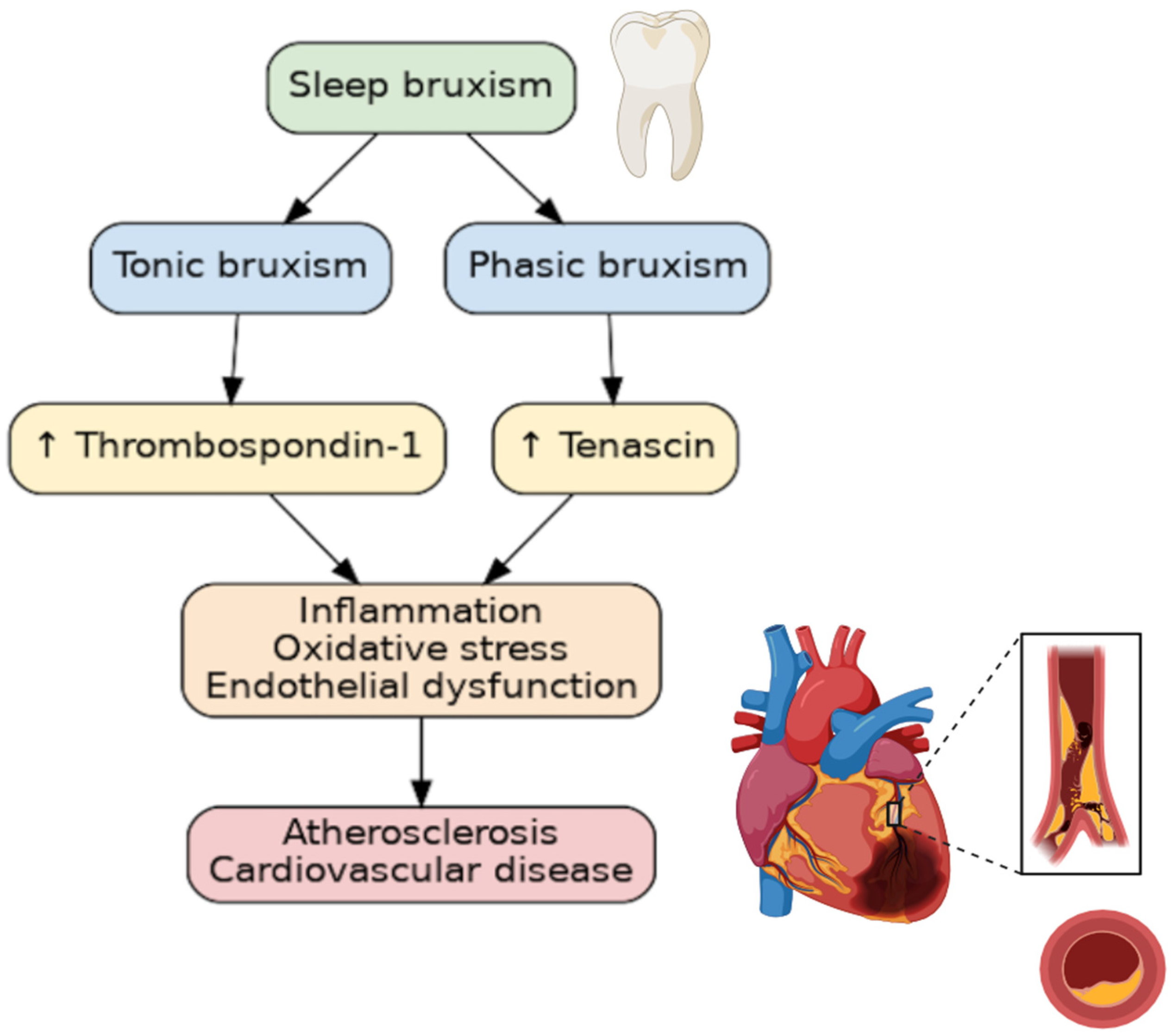
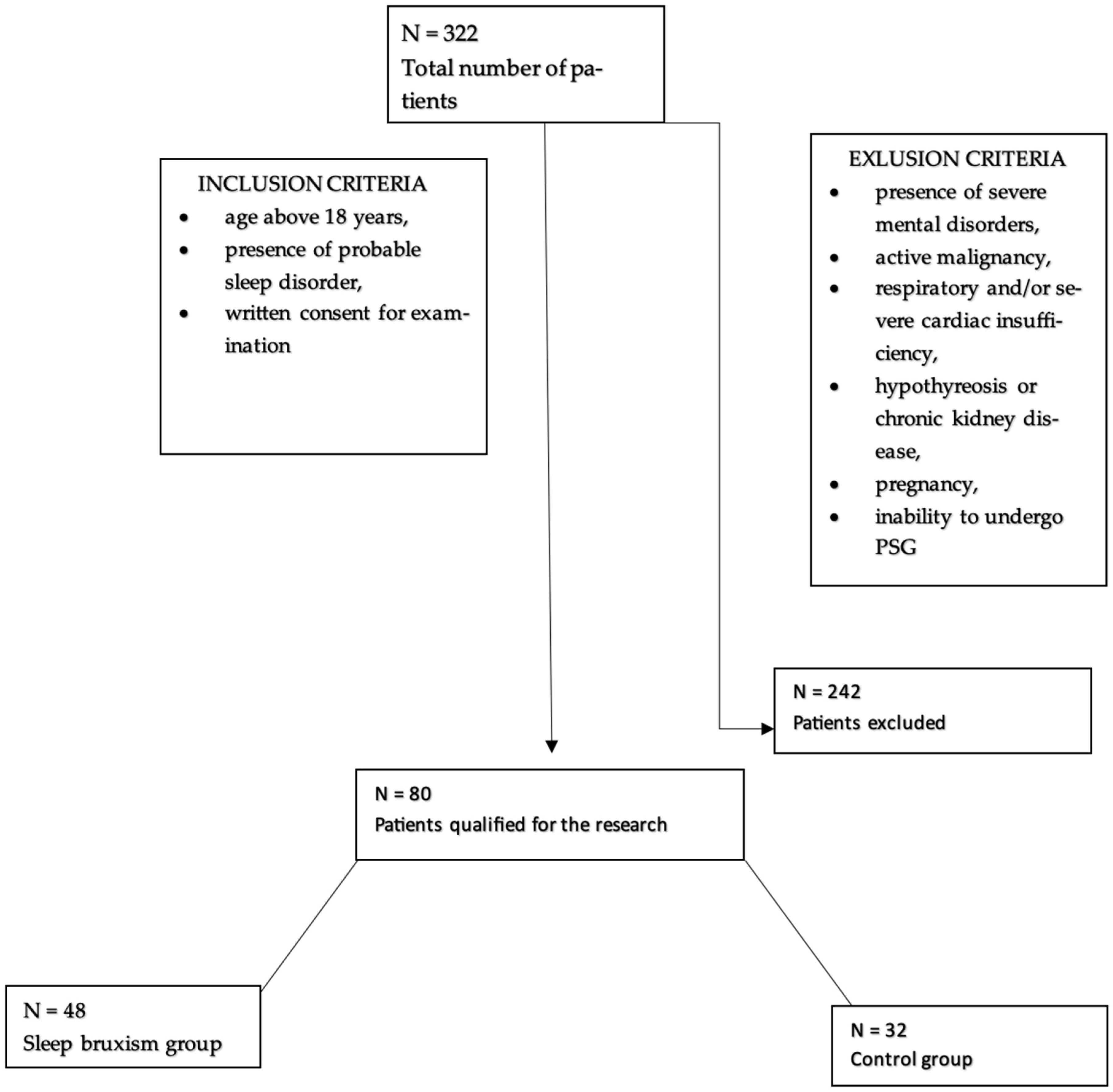
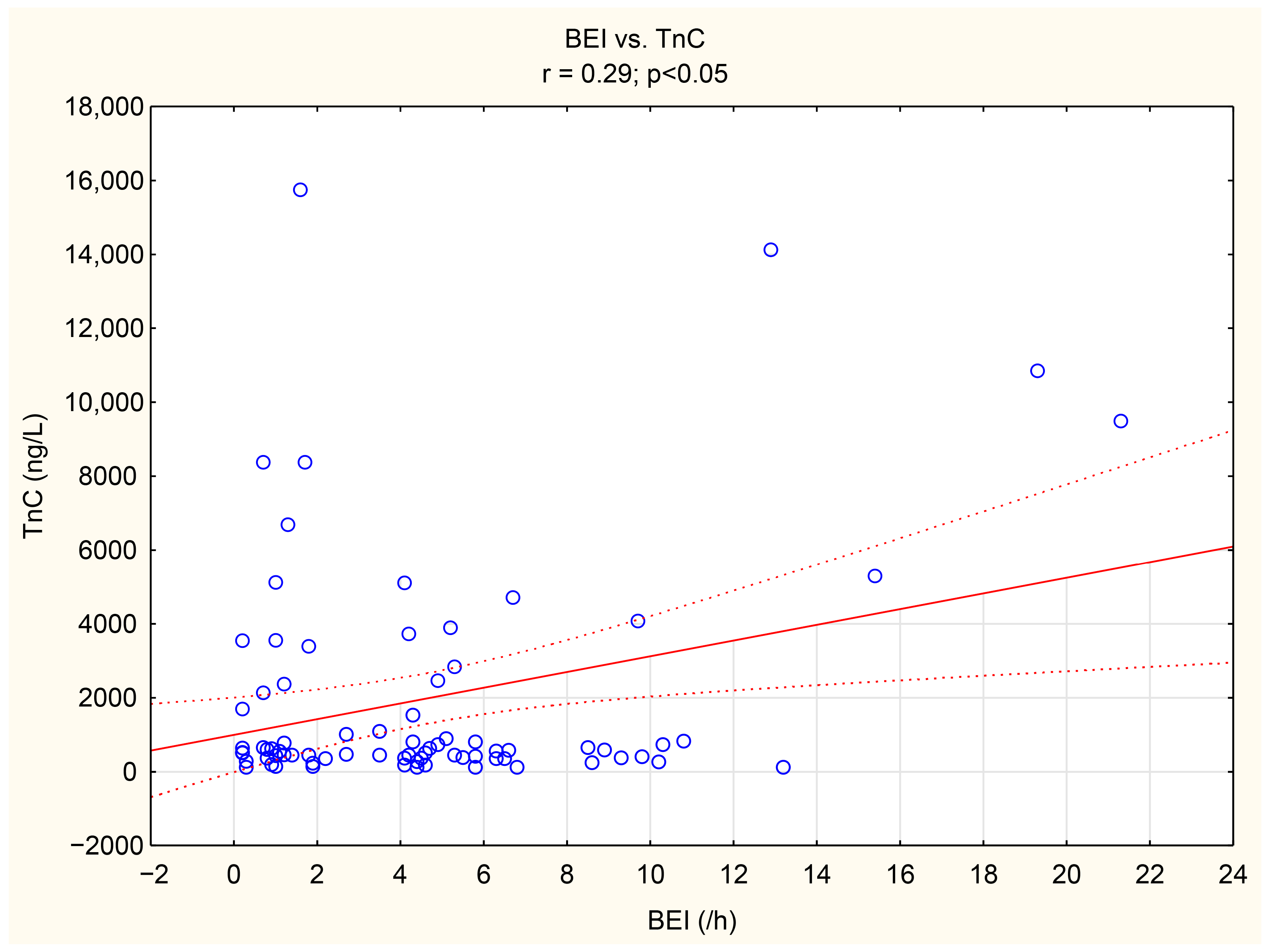
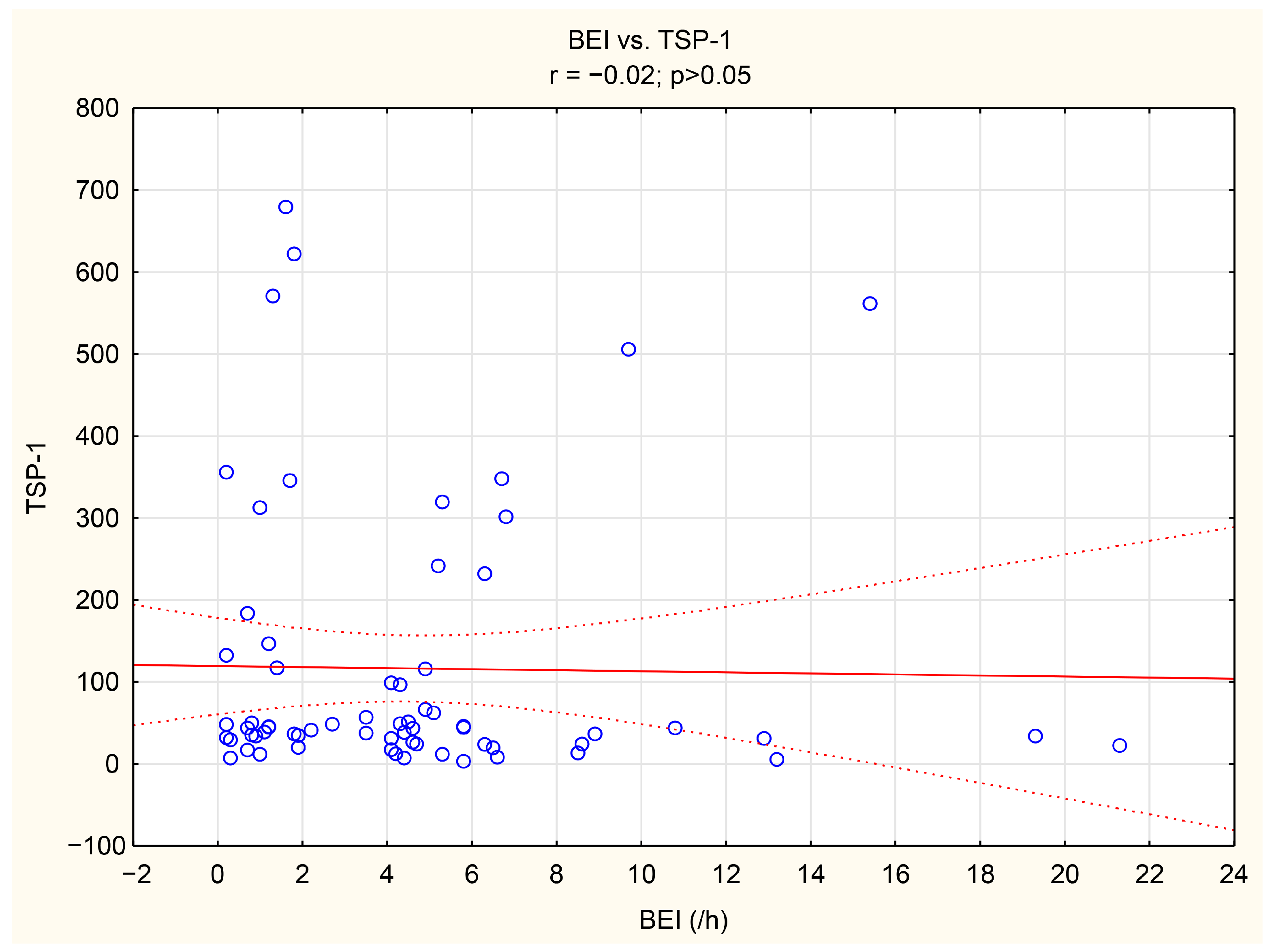
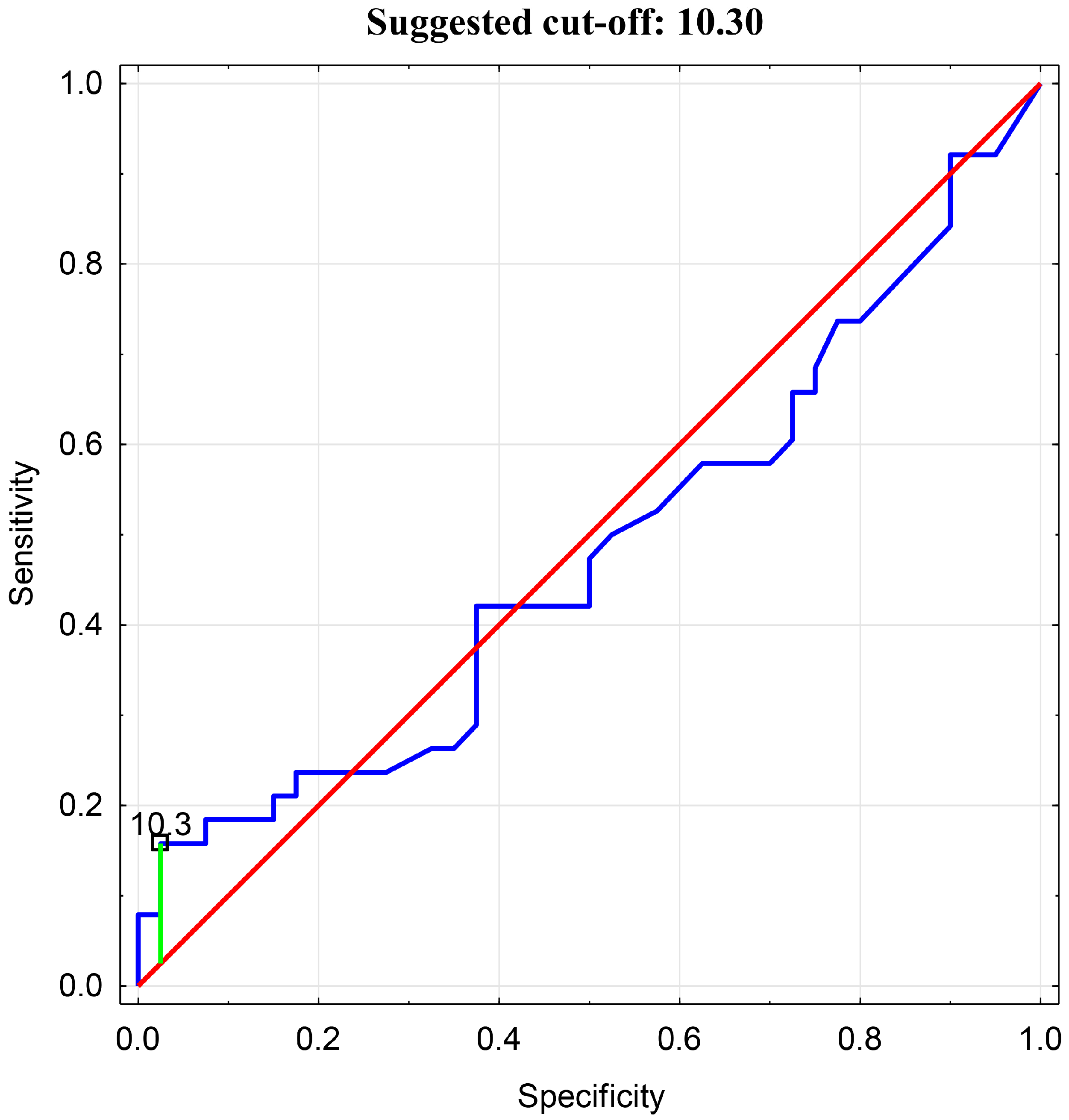
| Parameter | Mean | Minimum | Maximum | SD |
|---|---|---|---|---|
| Age (years) | 49.76 | 20 | 81 | 16.86 |
| Glucose (mg/dL) | 104.87 | 71 | 216 | 27.94 |
| Creatinine (mg/dL) | 0.93 | 0.65 | 1.52 | 0.14 |
| Uric Acid (mg/dL) | 5.22 | 2.3 | 11.1 | 1.47 |
| CRP (C-Reactive Protein) (mg/L) | 2.59 | 0.1 | 30.4 | 4.32 |
| ESR (erythrocyte sedimentation rate) (mm/h) | 8.06 | 1 | 38 | 7.08 |
| Total Cholesterol (mg/dL) | 197.99 | 105 | 304 | 45 |
| HDL (high-density lipoprotein) (mg/dL) | 56.33 | 32 | 93 | 14.27 |
| LDL (low-Density Lipoprotein) (mg/dL) | 113.18 | 41 | 207 | 39.43 |
| Triglycerides—TG (mg/dL) | 137.68 | 47 | 472 | 71.35 |
| Sodium—Na (mmol/L) | 139.91 | 135 | 149 | 2.11 |
| Potassium—K (mmol/L) | 4.28 | 3.37 | 5.17 | 0.31 |
| Calcium—Ca (mg/dL) | 9.35 | 8.5 | 10.2 | 0.3 |
| Magnesium—Mg (mg/dL) | 1.93 | 1.4 | 2.4 | 0.21 |
| Iron (µg/dL) | 115.7 | 19 | 206 | 48.06 |
| TIBC (Total Iron Binding Capacity) (µg/dL) | 339.64 | 270 | 482 | 47.73 |
| Transferrin (g/L) | 2.61 | 1.91 | 3.95 | 0.43 |
| Ferritin (ng/mL) | 138.61 | 0.8 | 452.4 | 112.52 |
| Vitamin D (ng/mL) | 31.71 | 11.5 | 132 | 16.12 |
| Parameter | Class | Number | % |
|---|---|---|---|
| Smoking | NO | 52 | 76.47 |
| YES | 16 | 23.53 | |
| Arterial | NO | 39 | 56.52 |
| YES | 30 | 43.48 | |
| CNS disease | NO | 63 | 91.3 |
| YES | 6 | 8.7 | |
| Myocardial infarction | NO | 64 | 92.75 |
| YES | 5 | 7.25 | |
| Stroke | NO | 66 | 95.65 |
| YES | 3 | 4.35 | |
| Diabetes | NO | 58 | 84.06 |
| YES | 11 | 15.94 |
| Parameter | N | Mean | Minimum | Maximum | SD |
|---|---|---|---|---|---|
| AHI (n/h) | 80 | 21.99 | 0.20 | 97.80 | 24.58 |
| SL (min) | 80 | 18.90 | 0.30 | 148.70 | 24.35 |
| WASO (min) | 80 | 70.05 | 0.00 | 287.00 | 60.60 |
| SE (%) | 80 | 81.08 | 45.70 | 99.00 | 13.28 |
| N1 (% of TST) | 80 | 7.89 | 0.20 | 41.00 | 7.41 |
| N2 (% of TST) | 80 | 47.68 | 17.60 | 186.50 | 19.33 |
| N3 (% of TST) | 80 | 28.13 | 0.10 | 289.50 | 30.96 |
| REM (% of TST) | 80 | 21.46 | 0.00 | 46.70 | 8.49 |
| Snore (% of TST) | 80 | 21.90 | 0.00 | 79.30 | 21.73 |
| PLMS Index (n/h) | 80 | 8.76 | 0.00 | 64.10 | 14.14 |
| AI (n/h) | 80 | 21.46 | 0.00 | 46.70 | 8.49 |
| RERAs (n/h) | 80 | 0.28 | 0.00 | 2.10 | 0.47 |
| ODI (n/h) | 80 | 19.89 | 0.50 | 92.20 | 22.48 |
| Mean SpO2 (%) | 80 | 81.23 | 51.00 | 94.00 | 9.77 |
| SpO2 Duration < 90% | 80 | 11.85 | 0.00 | 70.60 | 18.13 |
| BEI (n/h) | 78 | 4.63 | 0.20 | 21.30 | 4.31 |
| Phasic BEI (n/h) | 78 | 2.40 | 0.00 | 16.10 | 2.87 |
| Tonic BEI (n/h) | 78 | 1.49 | 0.00 | 7.30 | 1.52 |
| Mixed BEI (n/h) | 78 | 0.74 | 0.00 | 4.00 | 0.83 |
| BEI supine (n/h) | 78 | 8.06 | 0.00 | 93.90 | 12.81 |
| BEI non-supine (n/h) | 73 | 3.14 | 0.00 | 21.00 | 3.82 |
| BEI N1 (n/h) | 78 | 18.25 | 0.00 | 75.80 | 17.61 |
| BEI N2 (n/h) | 78 | 4.84 | 0.00 | 26.20 | 5.24 |
| BEI N3 (n/h) | 78 | 1.88 | 0.00 | 10.30 | 2.31 |
| BEI REM (n/h) | 78 | 4.28 | 0.00 | 101.00 | 11.49 |
| Parameter | BEI < 2 | BEI > 2 | SD < 2 | SD > 2 | p-Value |
|---|---|---|---|---|---|
| Tenascin-C | 2310.18 | 3491.42 | 1782.22 | 2933.15 | 0.47 |
| Thrombospondin-1 | 153.74 | 201.09 | 92.85 | 133.93 | 0.14 |
| Parameter | BEI < 4 | BEI > 4 | SD < 4 | SD > 4 | p-value |
| Tenascin-C | 2077.16 | 3278.25 | 1910.49 | 3074.79 | 0.82 |
| Thrombospondin-1 | 139.39 | 190.40 | 97.90 | 140.19 | 0.31 |
| Tenascin-C | Thrombospondin-1 | |
|---|---|---|
| BEI (n/h) | 0.29 * | −0.02 |
| Phasic BEI (n/h) | 0.32 * | −0.07 |
| Tonic BEI (n/h) | 0.11 | 0.04 * |
| Mixed BEI (n/h) | 0.20 | 0.07 |
| BEI supine | 0.14 | 0.01 |
| BEI non-supine | 0.28 * | 0.06 |
| BEI N1 (n/h) | 0.11 | 0.06 |
| BEI N2 (n/h) | 0.28 * | 0.03 |
| BEI N3 (n/h) | 0.11 | 0.06 |
| BEI REM (n/h) | −0.04 | −0.06 |
| Variable | b | SE | t(26) | p |
|---|---|---|---|---|
| Phasic BEI (n/h) | 807.100 | 362.396 | 2.227 | 0.035 |
| Smoking | 2188.872 | 1078.257 | 1.712 | 0.045 |
| Age (year) | 56.880 | 236.457 | 1.560 | 0.031 |
| AHI (n/h) | −41.802 | 28.879 | −1.447 | 0.160 |
| Myocardial Infarction | −3635.262 | 2939.511 | −1.237 | 0.227 |
| BEI non-supine (n/h) | −286.545 | 253.524 | −1.130 | 0.269 |
| Heart Disease | 2424.893 | 2788.043 | 0.870 | 0.392 |
| Glucose (mg/dL) | −10,935 | 22,803 | −0.480 | 0.636 |
| BEI N2 (n/h) | −117.857 | 308.779 | −0.382 | 0.706 |
| Male | 430.016 | 1246.457 | 0.345 | 0.733 |
| Stroke | 955.630 | 2876.271 | 0.332 | 0.742 |
| BEI (n/h) | 90.718 | 395.028 | 0.230 | 0.820 |
| Diabetes | −481.620 | 2145.273 | −0.225 | 0.824 |
| HDL (mg/dL) | −291.825 | 1890.910 | −0.154 | 0.879 |
| LDL (mg/dL) | −265.831 | 1896.151 | −0.140 | 0.890 |
| Triglycerides (mg/dL) | −52.689 | 379.028 | −0.139 | 0.891 |
| Total Cholesterol level (mg/dL) | 263.395 | 1895.443 | 0.139 | 0.891 |
| CRP (mg/L) | 13.508 | 99.595 | 0.136 | 0.893 |
| Arterial hypertension | −131.315 | 1026.467 | −0.128 | 0.899 |
| Variable | b | SE | t(21) | p-Value |
|---|---|---|---|---|
| Smoking | 57.602 | 26.658 | 0.665 | 0.035 |
| Tonic BEI (n/h) | 5.235 | 2.681 | 0.541 | 0.036 |
| Arterial hypertension | −94.776 | 76.253 | −1.243 | 0.228 |
| HDL (mg/dL) | 140.228 | 144.811 | 0.968 | 0.344 |
| LDL (mg/dL) | 137.680 | 145.481 | 0.946 | 0.355 |
| Total cholesterol level (mg/dL) | −137.581 | 145.461 | −0.946 | 0.355 |
| Triglycerides (mg/dL) | 27.083 | 28.907 | 0.937 | 0.359 |
| AHI (n/h) | −2.401 | 2.568 | −0.935 | 0.361 |
| Glucose level (mg/dL) | 1.548 | 2.024 | 0.765 | 0.453 |
| Age (year) | 2.565 | 3.407 | 0.753 | 0.460 |
| Male | 68.533 | 95.774 | 0.716 | 0.482 |
| Diabetes | −92.750 | 212.178 | −0.437 | 0.666 |
| Stroke | −72.635 | 283.022 | −0.257 | 0.800 |
| CRP (mg/L) | −6.248 | 28.580 | −0.219 | 0.829 |
| Myocardial Infarction | −21.713 | 225.135 | −0.096 | 0.924 |
| Coronary Heart Disease | 17.392 | 215.968 | 0.081 | 0.937 |
Disclaimer/Publisher’s Note: The statements, opinions and data contained in all publications are solely those of the individual author(s) and contributor(s) and not of MDPI and/or the editor(s). MDPI and/or the editor(s) disclaim responsibility for any injury to people or property resulting from any ideas, methods, instructions or products referred to in the content. |
© 2025 by the authors. Licensee MDPI, Basel, Switzerland. This article is an open access article distributed under the terms and conditions of the Creative Commons Attribution (CC BY) license (https://creativecommons.org/licenses/by/4.0/).
Share and Cite
Martynowicz, H.; Kosacka, M.; Macek, P.; Lachowicz, G.; Poręba, R.; Kusnerz, A.; Jaremków, A.; Daroszewski, C.; Bronowicka-Szydełko, A.; Madziarska, K.; et al. Tenascin-C and Thrombospondin-1 as a Potential Link Between Sleep Bruxism and Cardiovascular Diseases—A Case–Control Study. J. Clin. Med. 2025, 14, 6669. https://doi.org/10.3390/jcm14186669
Martynowicz H, Kosacka M, Macek P, Lachowicz G, Poręba R, Kusnerz A, Jaremków A, Daroszewski C, Bronowicka-Szydełko A, Madziarska K, et al. Tenascin-C and Thrombospondin-1 as a Potential Link Between Sleep Bruxism and Cardiovascular Diseases—A Case–Control Study. Journal of Clinical Medicine. 2025; 14(18):6669. https://doi.org/10.3390/jcm14186669
Chicago/Turabian StyleMartynowicz, Helena, Monika Kosacka, Piotr Macek, Gabriella Lachowicz, Rafal Poręba, Agnieszka Kusnerz, Aleksandra Jaremków, Cyryl Daroszewski, Agnieszka Bronowicka-Szydełko, Katarzyna Madziarska, and et al. 2025. "Tenascin-C and Thrombospondin-1 as a Potential Link Between Sleep Bruxism and Cardiovascular Diseases—A Case–Control Study" Journal of Clinical Medicine 14, no. 18: 6669. https://doi.org/10.3390/jcm14186669
APA StyleMartynowicz, H., Kosacka, M., Macek, P., Lachowicz, G., Poręba, R., Kusnerz, A., Jaremków, A., Daroszewski, C., Bronowicka-Szydełko, A., Madziarska, K., & Gać, P. (2025). Tenascin-C and Thrombospondin-1 as a Potential Link Between Sleep Bruxism and Cardiovascular Diseases—A Case–Control Study. Journal of Clinical Medicine, 14(18), 6669. https://doi.org/10.3390/jcm14186669








